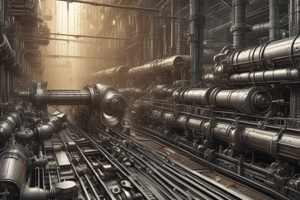Podcast
Questions and Answers
What is powder metallurgy (PM)?
What is powder metallurgy (PM)?
A metal processing technology in which parts are produced from metallic powders.
What is the heating treatment called in powder metallurgy?
What is the heating treatment called in powder metallurgy?
Sintering
What is a significant advantage of powder metallurgy?
What is a significant advantage of powder metallurgy?
- Poor dimensional control
- Can mass produce parts to net or near net shape (correct)
- All metals can be made from powders
- Produces parts with high waste material
Which of the following is a disadvantage of powder metallurgy?
Which of the following is a disadvantage of powder metallurgy?
Powder metallurgy can produce parts that have a specified level of __________.
Powder metallurgy can produce parts that have a specified level of __________.
What is one of the methods used to produce metallic powders?
What is one of the methods used to produce metallic powders?
Name one of the three principal methods by which metallic powders are produced.
Name one of the three principal methods by which metallic powders are produced.
Powder metallurgy can only produce parts that weigh less than 10 kg.
Powder metallurgy can only produce parts that weigh less than 10 kg.
What is a major disadvantage of using water in the atomization process?
What is a major disadvantage of using water in the atomization process?
Flashcards are hidden until you start studying
Study Notes
Introduction to Powder Metallurgy
- Powder metallurgy (PM) transforms metallic powders into parts through compression and heating.
- Compression, or pressing, shapes the powders using specialized tool designs, often resulting in high tooling costs.
- Sintering occurs at temperatures below the metal's melting point, bonding the particles into a solid mass.
Advantages of Powder Metallurgy
- Enables mass production of parts to net shape or near net shape, minimizing additional processing.
- High material efficiency: Approximately 97% of starting powders convert to final product.
- Produces parts with controlled porosity for applications like filters and oil-impregnated bearings.
- Capable of fabricating hard-to-shape metals like tungsten, used in incandescent bulbs.
- Effective for unique metal alloy combinations and cermets that other methods cannot produce.
- Dominates casting processes in terms of dimensional accuracy, with tolerances routinely at 0.13 mm (0.005 in).
- PM processes can be automated, enhancing production economics.
Disadvantages and Limitations of Powder Metallurgy
- High initial costs for tooling and equipment.
- Metallic powders can be expensive and pose storage and handling issues.
- Metal powders may degrade over time, and some have fire hazards.
- Design limitations exist due to poor lateral flow of powders in the die, requiring ejector allowances.
- Challenges with material density uniformity, especially in complex geometries.
- Most PM components typically weigh less than 2.2 kg (5 lb).
Characterization of Engineering Powders
- Powders can be categorized by:
- Particle size and distribution
- Shape and internal structure
- Surface area
- Interparticle friction and flow characteristics
- Packing, density, and porosity
- Chemistry and surface films
Production Methods for Metallic Powders
- Methods for creating metallic powders involve energy input to increase the surface area.
- Principal methods include:
- Atomization
- Chemical
- Electrolytic
- Mechanical methods are usually linked with ceramic powder production.
Atomization Process
- Atomization converts molten metal into droplets that solidify as powders, widely used for all metals.
- Gas atomization employs a high-velocity gas stream to atomize molten metal through a nozzle.
- Gravity-assisted methods atomize molten metal with air jets, creating spherical powders.
- Water atomization, favored for metals melting below 1600°C, leads to irregular powder shapes due to rapid cooling but risks oxidation.
- Synthetic oil is a recent alternative to water in atomization to mitigate oxidation.
- Particle size in atomization processes varies inversely with fluid stream velocity.
Studying That Suits You
Use AI to generate personalized quizzes and flashcards to suit your learning preferences.




